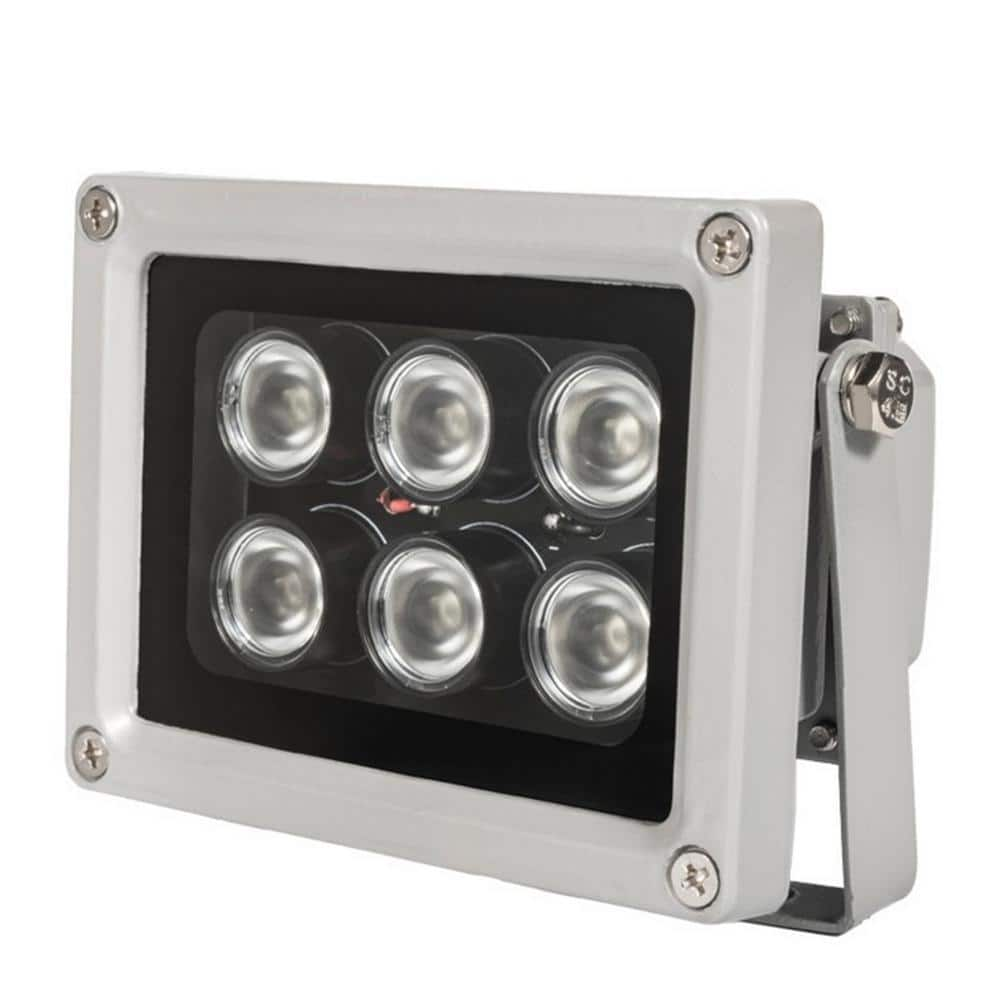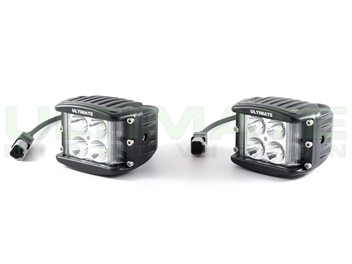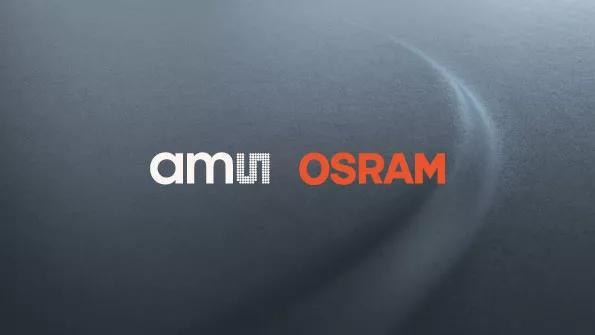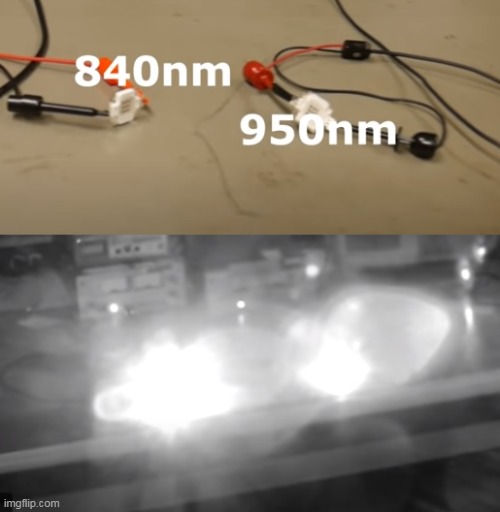Does anyone have any experience setting remote IR illumination at known distances/locations to allow passive NV to see better without using a long range illuminator?
Surely someone in Texas that shoots over bait has already thought of this?
I looked at TNVC and NG and all I saw was the Rigid 32.2w products for vehicle use.
I want to set up a solar or battery, probably 12v, to run a 10w - 30w IR.
I see this stuff on ebay, but I'm not finding 940nm, I guess I can live with the glow if it's not attached to me, but I'd like to get it right the first time if possible.
10W 10 watt IR 940nm Infra-red Round High Power LED Chip Bead bulb Lamp 4-5V
Input Voltage: 4-5V DC
Power: 10W 3 series by 3 parallel
Power Consumption: 10W
Current: 1050mA constant input
LED qty: 9pcs 1w high intensity chip LED
Lumen output: 1000Lm
Color temperature: IR 940NM
Beam Anlge: 145degree
Package:
1pcs 10W Round 940NM led chip
-------------------------------------------------------------------------------------------
SuperBright has a fairly good reputation, this package is only $70.
Unfortunately, it's 850nm.

 www.superbrightleds.com
www.superbrightleds.com
This infrared LED light bar works with night vision goggles and cameras to dramatically increase visibility while maintaining stealth. The IR light bar emits an 850-nanometer wavelength of energy that is nearly invisible to the naked eye. 2 rows 18 LEDs produce a 35° beam pattern from the 11” bar. A rugged polycarbonate lens and aluminum housing with integrated heat sink keep the internal components protected and cool. Adjustable stainless steel mounting brackets and installation hardware are included. Featured Bottom Bullets:
Product Details:
Here's a HomeDepot $40 12v 940nm

This is a little more than I'd like to spend at $229 a pair, so a little over a hunnert each plus a power supply

 ultimatenightvision.com
ultimatenightvision.com
$199 a pair for flood

 ultimatenightvision.com
ultimatenightvision.com
-40C to 155C
Power Source
9-36V
Light Source
OSRAM LED
Light Wavelength
940 nm
Compatible With
Gen3 Night Vision;Digital Night Vision
Mean Time to Failure
50
---------------------------------------------------
*****WARNING ------NERD-OUT----USE PRONHUBLINK IF NECESSARY*****
OSRAM LED Light Wavelength 940 nm

 www.osram.com
www.osram.com
Osram Opto Semiconductors is expanding its proven Oslon Black portfolio for infrared illumination with the addition of an infrared LED with a narrower beam angle of ± 25°. Thanks to the new SFH 4718A IRED, illumination units for camera systems with a medium capture range no longer require secondary optics. The Oslon Black family now offers a wide selection for the most varied of infrared-based applications, taking in four power classes, three wavelengths and three beam angles.
“With the addition of the SFH 4718A, the Oslon Black portfolio now comprises three wavelengths (810 nm, 850 nm and 940 nm) and three beam angles (±25°, ±45° and ±75°). These are flanked by four different power levels, with optical outputs ranging from 0.3 W right through to 2 W”, said Jörg Heerlein, Marketing Emitter Laser Sensor at Osram Opto Semiconductors. “Since all the products are based on the same package, the emitters are easy to combine. And since the footprint remains identical, an existing design can also be easily upgraded with a new variant.”
https://www.osram.com/ecat/OSLON®%20Black%20SFH%204718A/com/en/class_pim_web_catalog_103489/prd_pim_device_2219997/
 www.osram.com
www.osram.com
Surely someone in Texas that shoots over bait has already thought of this?
I looked at TNVC and NG and all I saw was the Rigid 32.2w products for vehicle use.
I want to set up a solar or battery, probably 12v, to run a 10w - 30w IR.
I see this stuff on ebay, but I'm not finding 940nm, I guess I can live with the glow if it's not attached to me, but I'd like to get it right the first time if possible.
10W 10 watt IR 940nm Infra-red Round High Power LED Chip Bead bulb Lamp 4-5V
Input Voltage: 4-5V DC
Power: 10W 3 series by 3 parallel
Power Consumption: 10W
Current: 1050mA constant input
LED qty: 9pcs 1w high intensity chip LED
Lumen output: 1000Lm
Color temperature: IR 940NM
Beam Anlge: 145degree
Package:
1pcs 10W Round 940NM led chip
-------------------------------------------------------------------------------------------
SuperBright has a fairly good reputation, this package is only $70.
Unfortunately, it's 850nm.

11
This infrared LED light bar works with night vision goggles and cameras to dramatically increase visibility while maintaining stealth. The IR light bar emits an 850-nanometer wavelength of energy that is nearly invisible to the naked eye. 2 rows 18 LEDs produce a 35° beam pattern from the 11”...
This infrared LED light bar works with night vision goggles and cameras to dramatically increase visibility while maintaining stealth. The IR light bar emits an 850-nanometer wavelength of energy that is nearly invisible to the naked eye. 2 rows 18 LEDs produce a 35° beam pattern from the 11” bar. A rugged polycarbonate lens and aluminum housing with integrated heat sink keep the internal components protected and cool. Adjustable stainless steel mounting brackets and installation hardware are included. Featured Bottom Bullets:
Product Details:
- Includes pigtail connector
- Installation hardware included
- Operating temperature: -40 to +122 °F
- Rated IP67 for wet conditions
- 12-28 VDC
Here's a HomeDepot $40 12v 940nm

SPT 940nm 6 LED 60-Degree IR Illuminator for Security Cameras 15-IL056 - The Home Depot
This is an Indoor/Outdoor IR Illuminator. This illuminator offers an 60° field of illumination at a range of up to 45 ft. with a total of 6 powerful LED's. 100% completely covert with 940nm Invisible Light. This illuminator is weather resistant for outdoor use and is IP67 compliant. DC12V. Power...
www.homedepot.com
Product Overview
This is an Indoor/Outdoor IR Illuminator. This illuminator offers an 60° field of illumination at a range of up to 45 ft. with a total of 6 powerful LED’s. 100% completely covert with 940nm Invisible Light. This illuminator is weather resistant for outdoor use and is IP67 compliant. DC12V. Power supply does not included.- IR LED’s: 6-pieces high power LED IR lights
- 100% completely covert with 940nm LED wavelength (invisible light)
- Structure: aluminum body
- 60° field of illumination at a range of up to 45 ft.
- Waterproof level: IP67
- Power input: DC 12-Volt/1 Amp (plug size 5.5 x 2.1 mm) power adapter not included
This is a little more than I'd like to spend at $229 a pair, so a little over a hunnert each plus a power supply

ULTIMATE 2" LT-IR 940nm Infrared LED Light Cubes - Dual Row Lateral Throw Pair
The ULTIMATE 2" IR Side Shooter Lateral Throw Light Cubes use 2 rows of 940nm infrared LEDs with spot a reflectors to throw a beam pattern specifically designed for short range navigation illumination. The beam disperses 940nm
 ultimatenightvision.com
ultimatenightvision.com $199 a pair for flood

ULTIMATE 2" 940nm Infrared LED Light Cubes - Dual Row Flood Pair
The ULTIMATE 2" IR Light Cubes use 2 rows of 940nm infrared LEDs with flood reflectors to throw a beam pattern specifically designed for short range navigation illumination. The beam disperses 940nm light to the left and right for optimal visibility in co
 ultimatenightvision.com
ultimatenightvision.com Environmental Specifications
Operating Temperature Range-40C to 155C
Power Source
9-36V
Light Source
OSRAM LED
Light Wavelength
940 nm
Compatible With
Gen3 Night Vision;Digital Night Vision
Mean Time to Failure
50
---------------------------------------------------
*****WARNING ------NERD-OUT----USE PRONHUBLINK IF NECESSARY*****
OSRAM LED Light Wavelength 940 nm
News - ams-osram - ams
Explore our latest innovations in sensing, illumination and visualization and browse through ams OSRAM news, blog articles, webinars and podcasts.
Osram Opto Semiconductors is expanding its proven Oslon Black portfolio for infrared illumination with the addition of an infrared LED with a narrower beam angle of ± 25°. Thanks to the new SFH 4718A IRED, illumination units for camera systems with a medium capture range no longer require secondary optics. The Oslon Black family now offers a wide selection for the most varied of infrared-based applications, taking in four power classes, three wavelengths and three beam angles.
“With the addition of the SFH 4718A, the Oslon Black portfolio now comprises three wavelengths (810 nm, 850 nm and 940 nm) and three beam angles (±25°, ±45° and ±75°). These are flanked by four different power levels, with optical outputs ranging from 0.3 W right through to 2 W”, said Jörg Heerlein, Marketing Emitter Laser Sensor at Osram Opto Semiconductors. “Since all the products are based on the same package, the emitters are easy to combine. And since the footprint remains identical, an existing design can also be easily upgraded with a new variant.”
https://www.osram.com/ecat/OSLON®%20Black%20SFH%204718A/com/en/class_pim_web_catalog_103489/prd_pim_device_2219997/
IR OSLON® Black Family | OSRAM
The IR OSLON Black is today’s smallest infrared LED with more than one watt of optical power. The small package allows compact arrangements of very high power density
- IR lightsource with high efficiency up to 50%
- very compact SMT package with integrated lenses (+/-25°, +/- 40°, +/- 75°) for dense clustering
- Low thermal resistance
- 850nm and 940nm wavelength available
- Industry and automotive grade product family available
- long lifetime up to 50.000 h
Last edited:


